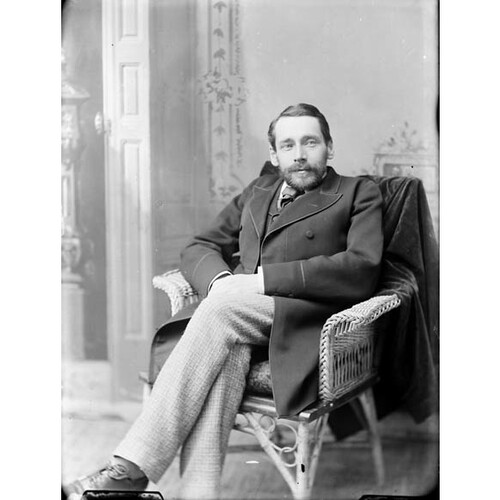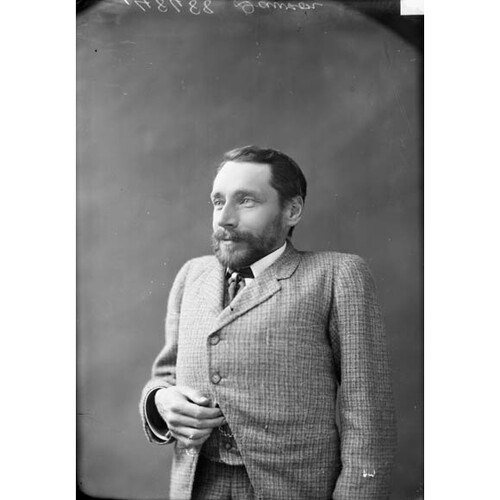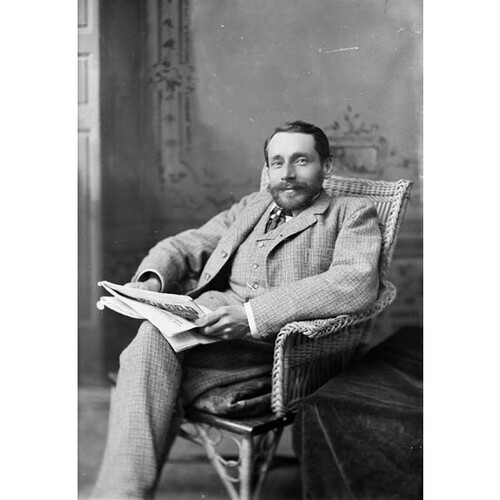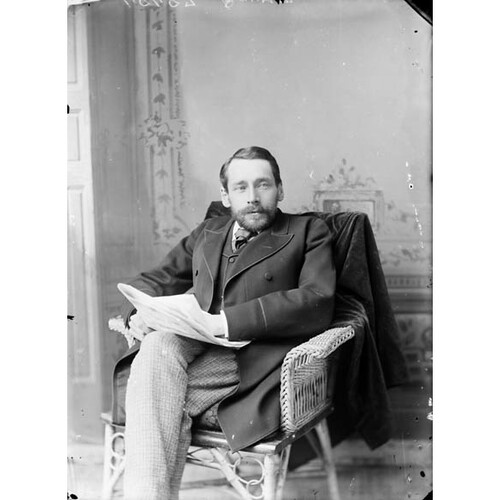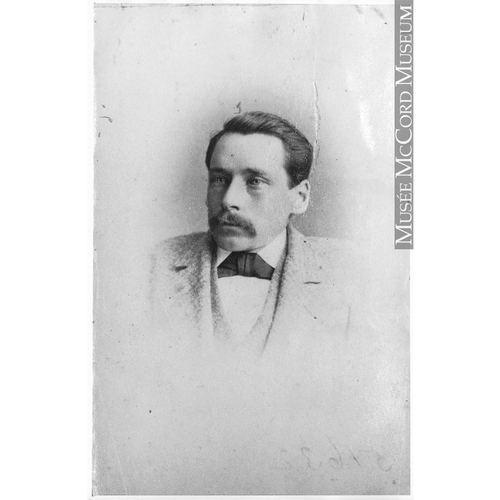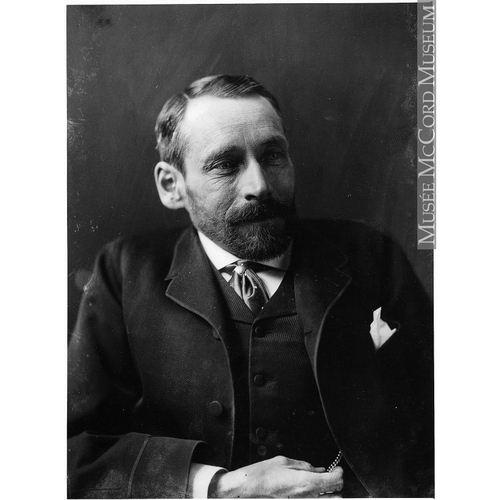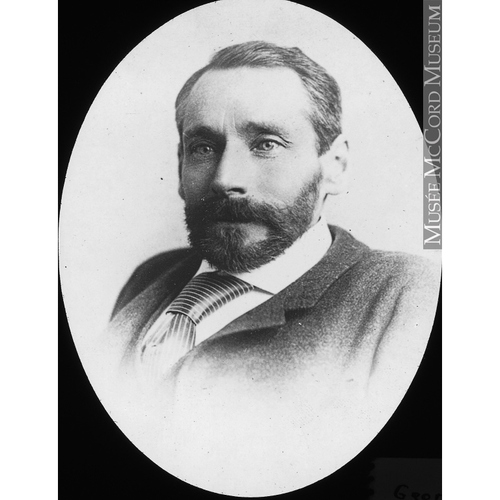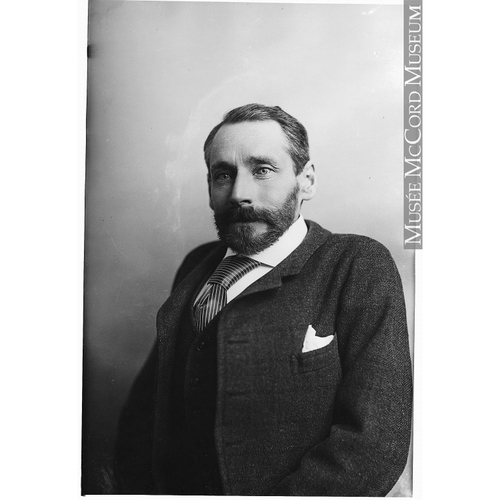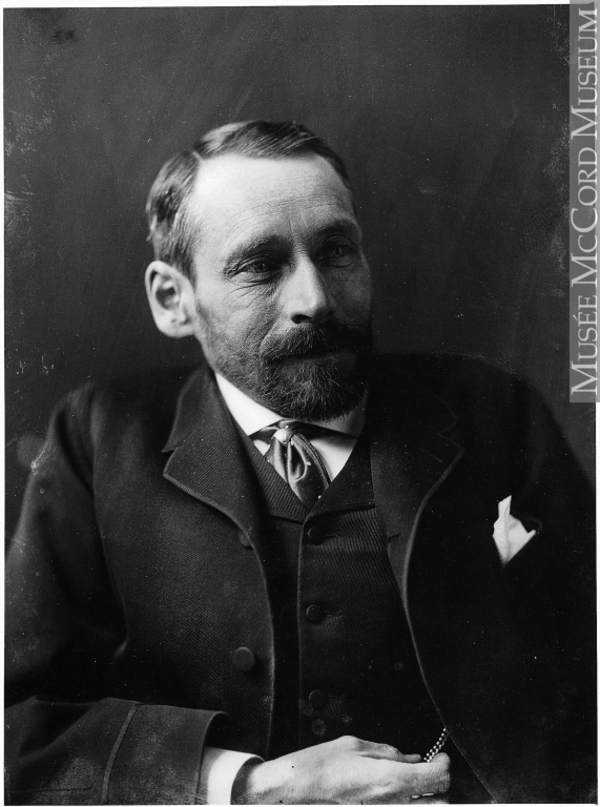
Source: Link
DAWSON, GEORGE MERCER, geologist, author, teacher, civil servant, geographer, anthropologist, and palaeontologist; b. 1 Aug. 1849 in Pictou, N.S., son of John William Dawson* and Margaret Ann Young Mercer; d. unmarried 2 March 1901 in Ottawa.
George Dawson lived in Nova Scotia until 1855, when his father became principal of McGill College, Montreal. The wilds of the McGill grounds reinforced in George a love of nature as a field for study that his father, an eminent geologist, had inspired. Young George collected natural-history specimens on Mount Royal and worked with the elder Dawson in the college museum. He excelled in his studies at the High School of Montreal in 1858, but was forced to withdraw by the onset of a serious illness, apparently tuberculosis of the spine (Pott’s disease). The physical effects were devastating: Dawson suffered a spinal curvature that deformed his upper body, stunted his growth, and left him with recurring headaches. These handicaps would make his later accomplishments as an explorer all the more remarkable. Private studies until he was 18 nurtured his orderly mind, insatiable intellectual curiosity, broadly perceptive intelligence, and attractive personality with strong leadership qualities, attributes that would find both artistic and scientific expression. In 1868–69 Dawson attended McGill College, and he spent the summer of 1869 at Gaspé dredging for foraminifers in order to study the geographical distribution of these minute shelled animals. He would publish the resulting paper in 1870 in Canadian, American, and British scientific journals.
In autumn 1869 a combination of Dawson’s rarefied scientific upbringing, natural ability, and ambition won him one of the finest opportunities for a professional scientific education then available. He enrolled at the Royal School of Mines, London, his path abroad smoothed by his father’s professional connections. The school, established in the afterglow of the Great Exhibition of 1851, was organized and staffed by the Geological Survey of Great Britain to promote along scientific lines the development of the mineral wealth of Britain and its colonies. Dawson gained intensive training there in geology (including fieldwork with the survey in the Lake District), natural history, palaeontology, chemistry, mining and metallurgy, and applied mechanics, from some of the best authorities in these fields. In particular, though his father remained staunchly anti-Darwinian, he studied natural history with “Darwin’s bulldog,” Thomas Henry Huxley. Huxley’s emphasis on the interrelation between natural history and geology, on the accumulation of scientific facts, and on the importance of geographical regions in the patterns of species distribution (reinforced in Robert Etheridge’s palaeontology course) would anchor Dawson’s later scientific work in a modern evolutionary approach. Dawson graduated with distinction in 1872, an associate of the school and winner of the Duke of Cornwall Scholarship, the Forbes Medal and Prize in natural history and palaeontology, and the Murchison Medal in geology. He had relished his field experience, and his outstanding academic record now virtually ensured him an appointment to a government survey or exploring expedition.
Rather than furthering his studies in Germany, Dawson in the summer of 1872 chose to return home. He contracted with several businessmen to assay coal and iron ores in Nova Scotia and taught chemistry at Morrin College, Quebec. When a position became available on the Geological Survey of Canada that year, its director, Alfred Richard Cecil Selwyn, decided to hold it open for Dawson, to allow him first to serve as naturalist and geologist on the international boundary survey from Lake of the Woods to the Rocky Mountains [see Samuel Anderson*].
For two years Dawson travelled with the survey, and his Report on the geology and resources of the region in the vicinity of the forty-ninth parallel . . . was published in 1875. Later hailed by mineralogist Bernard James Harrington as “one of the classics of Canadian geology,” it was widely recognized for its theoretical and practical achievements. Although the survey’s main purpose had been to demarcate the 49th parallel of latitude as a baseline for future investigations, Dawson added a remarkable multidimensional analysis that reflected his broad scientific training and became the prototype for his future work as a leader among the second generation of professional Canadian geologists. The report made original contributions to knowledge of the geology, natural history, and geography of territory more than 800 miles long and 60 miles wide across the middle section of North America. In geology Dawson helped illuminate the roles of metamorphism and glaciation in the formation of Pleistocene structures on the prairies, adding evidence that would fuel debates in North America for decades. He also turned his attention to Cretaceous formations, replete with fossils and younger than the Precambrian formations of the Canadian Shield which had preoccupied Sir William Edmond Logan*, director of the GSC before 1869. He mapped and analysed Tertiary lignites as a crucial source of fuel in a region bereft of trees. In natural history Dawson added more than 300 specimens of mammals and birds to the British Museum’s collections, and his report documented locust invasions to assess their threat to agriculture. In geography he mapped in detail a region largely unexplored since the expeditions of John Palliser* and Henry Youle Hind in the 1850s, and analysed with closely reasoned arguments its potential for settlement. The report would long remain the principal source of geological information for railway building on the plains. It also helped botanist John Macoun* and others to convince the Canadian public of a greater agricultural potential on the prairies than Dawson had envisaged. As a result, Dawson’s work for the boundary commission is recognized as an important stimulus to the settlement of western Canada. His report sold out almost immediately, remaining in demand even in the United States and generating spin-off publications in Dawson’s diverse areas of interest.
Having joined the GSC in the summer of 1875, Dawson spent the next two field-seasons in British Columbia. To his father’s dismay, the appointment in 1876 of Joseph Frederick Whiteaves over Dawson, to succeed Elkanah Billings* as staff palaeontologist, would keep Dawson in distant field service rather than in the offices of the GSC in Montreal for many more years. Yet the survey’s threefold mandate in the western territories – to outline their geological structures, to assess their mineral wealth and agricultural potential, and to advise in the construction of a Pacific railway – was eminently well served by Dawson. The high quality of his explorations inaugurated for the GSC a new era of systematic reconnaissance, and confirmed Dawson’s reputation as an expert in theoretical and practical geology, geography, and ethnology.
In geology and geography Dawson offered an outstanding contribution to the primary task of mapping and naming surface features in complex terrain. He addressed the difficult question of their origins, adding further considerations to the wider debate over glaciation. Evidence from his arduous investigations of western regions of Canada (British Columbia, 1875–77; the Red, Assiniboine, and Souris river regions, 1878–79; and the Skeena and Peace river valleys, 1879–80) allowed him to relate the British Cretaceous to the American Laramie formations. Dawson began gradually to admit the general theory that continental ice-sheets had extended from the polar ice-cap and sculpted the landscape. Yet he never relinquished entirely the alternative theory that drifting icebergs, as “local expressions” of the polar phenomena when the land had been submerged, explained the surficial geology of western Canada, including the Pleistocene formations of the prairies. Both Dawsons remained among the last major resisters of continental glacial theory, even though by 1879 George had conceded the probability of a more extensive Cordilleran ice-sheet, at least in British Columbia.
Although his conceptualizations did, however infrequently, fail at times to grasp complexities unravelled only later, Dawson’s model reports reveal his unmatched ability to observe and extrapolate accurately over vast expanses of terrain. His intellectual independence enabled him, for instance, to demonstrate that certain geological patterns could have been formed only by a northward movement of ice masses, rather than by southward movement from the polar cap. He managed as well to correlate evidence of metamorphism in Canada with volcanic activity in Chile and elsewhere. To these theoretical accomplishments he added invaluable practical inventories and assays of natural resources and their environments, most notably his General note on the mines and minerals of economic value of British Columbia . . . (1877) and Note on the distribution of some of the more important trees of British Columbia (1880), which would guide railway interests, mining prospectors, and potential settlers for years to follow.
It was in British Columbia that Dawson earned his reputation as “one of Canada’s foremost contributors to ethnology” and as a “father of Canadian anthropology.” He included systematic ethnological inventories in his geological surveys, intending his reports on native peoples to advise government in the formulation of policy. His Sketches of the past and present condition of the Indians of Canada (1879) surveyed the distribution and declining numbers of aboriginal peoples in the light of the apparent inevitability of political dominion in the west by European Canadians. Dawson’s view of Indian policy in the west was informed by ethnology. For him, as for other ethnologists, social evolution prophesied the inevitable extinction of “socially inferior” people. He followed the example of John Wesley Powell and other American ethnologists concerned with the “Indian question” and the moral dilemma created by the organized assault on native territory during the late 19th century. Like these Americans, who were motivated by a philanthropic concern for the plight of the vanishing tribes and by a desire to promote their social evolution, Dawson discouraged the government from pursuing policies of state tutelage and segregation on reserves. Instead, he encouraged a program of education and assimilation into white society.
Dawson’s convictions were confirmed in 1878 during a visit among the Haida, while he was exploring the Queen Charlotte Islands. As an artist and poet, he was captivated by the beauty of the Haida totem-poles and by the intelligence and skills reflected in the construction of their villages. As a Darwinian scientist, he perceived a highly evolved culture. This appreciation, and the stark reality of deserted villages and rapidly decreasing populations, prompted Dawson to add richly textured appendices, including a Haida vocabulary, to his much praised geological report on the islands (1878–79). He urged the encouragement through education of Haida crafts and trades, interpreting these skills in harmony with the industries that he knew would accompany Canadian settlement. He warned politicians that Haida culture also possessed “fully developed” concepts of property ownership that would demand consideration during negotiations over railway lands.
This experience with the Haida galvanized Dawson’s professional interest in ethnology and prodded him to preserve further evidence of their culture. He photographed and sketched their totem-poles, and sent artefacts to McGill College. Although Dawson was never again to enjoy as full an opportunity to conduct anthropological research, he reported on the Kwakiutl (1887) and the Shuswap (1891), distinguishing with pride the British Columbian ethnological from the Ontarian archaeological collections of the GSC. In addition, he collaborated with William Fraser Tolmie* on Comparative vocabularies of the Indian tribes of British Columbia . . . (1884), which included a linguistic map. Dawson’s pioneering research and dedication focused international attention on Canada’s rich ethnological heritage, earning him two appointments by the British Association for the Advancement of Science: in 1884 as local director of its committee to investigate the northwest tribes of Canada and in 1897 as chair of its committee on an ethnological survey of Canada. Drawing upon the talents of American anthropologist Franz Boas*, he combined support from the BAAS and the Royal Society of Canada to advance the cause of a national repository to retain artefacts in Canada at a time when museums abroad were competing for Canadian material. Dawson’s emphasis on collecting over other forms of anthropological fieldwork laid the foundations of the ethnological department of the present-day Canadian Museum of Civilization and deeply influenced the theoretical and institutional development of anthropology in this country.
Dawson also initiated national collections in zoology, especially of the remains of dinosaurs. These extinct reptiles had constituted a controversial topic when Dawson was studying at the RSM. He made his first discovery of fossils in 1874 near Lake of the Woods and subsequently along Red Deer River (Alta). This evidence of enormous prehistoric creatures was housed in Cretaceous formations, which Dawson related to the coal deposits he was employed to locate. The remarkable dinosaur collections inaugurated by Dawson were to form the core of the department of vertebrate palaeontology of the present National Museum of Natural Sciences.
Meanwhile, his geological fieldwork and annual reports for the GSC proceeded apace. During the 1880s Dawson was still intensively preoccupied with geological structures in the western and northern regions of the country. Although his theory that the Rocky Mountains had been formed with the Canadian Shield as their central axis would be disproven, his creative vision at the time was inspiring. His studies of the Bow and Belly river regions from 1880 identified important Cretaceous subgroups and concluded his reconnaissance of coal formations east of the Rocky Mountains. Dawson’s expertise on the uses of lignites as fuels, sharpened during a European tour in 1882, was consulted by the House of Commons’ standing committee on immigration and colonization in 1883 and was reflected by his authoritative Mineral wealth of British Columbia . . . (1889), published by both the GSC and the Canadian Pacific Railway. In 1883 he investigated the western slope of the Rockies, assisted by Joseph Burr Tyrrell* in the Crowsnest Pass, and the following year he surveyed the region of the Selkirk Mountains further north. In 1887 he published a cumulative “Geological map of the northern part of the Dominion of Canada east of the Rocky Mountains,” to which he added a paper On some of the larger unexplored regions of Canada (1890), an eloquent plea for continued exploration and mapping. The cautious optimism that characterized Dawson’s reports was instrumental in guiding the development of lode mining to make the Cordilleras the leading producer in Canada of gold and other metals. At the same time even Dawson could hardly contain his enthusiasm in his glowing reports of coal deposits, which, in the District of Alberta, he assessed as “practically inexhaustible.” It was these deposits, in fact, that spurred commercial activity by such entrepreneurs as Sir Alexander Tilloch Galt*.
In 1887 Dawson led an expedition to survey the Yukon territory, long known to harbour deposits of placer gold. Travelling up the Stikine River and then back to the coast via the headwaters of the Yukon River, he not only marked a location for the much-disputed Alaska boundary but described gold-bearing gravels and used glacial patterns to predict the possible discovery of workable deposits somewhere in the Yukon. Two editions of his report, which contained useful geological maps and access routes, sold out. It was generally interpreted as a harbinger of the Klondike gold-rush in 1898, during which Dawson City was named in his honour, despite the fact that he had not reached the Klondike during his survey.
After his first decade of fieldwork Dawson’s scientific accomplishments brought honours and administrative responsibilities. In 1883, two years after the GSC had moved its offices to Ottawa, he became an assistant director, and in 1885–86 he served as acting director while Selwyn was Canadian commissioner at the Antwerp exhibition and the Colonial and Indian Exhibition in London. In 1891 Dawson was named a fellow of the Royal Society of London and was awarded the Bigsby Medal of the Geological Society of London. That same year he served the British cause in the dispute with the United States over seal fisheries in the Bering Sea [see Clarence Nelson Cox], offering decisive testimony on the natural history of the region. For this contribution he was made a cmg in 1892. The following year he helped present the British case in the dispute to an arbitration panel in Paris. Honorary doctorates from Princeton (1887), Queen’s (1890), McGill (1891), and Toronto (1897) came his way, as did the presidency of the Ottawa Field-Naturalists’ Club (1891–94) and the associate editorship of the Journal of Geology (Chicago). In 1893 Dawson, a fellow of the RSC since 1882, was unanimously elected its president; his address the next year articulated a powerful argument for public funding in Canada of “all that field of scientific investigation which relates to our own vast territory.” Upon Selwyn’s retirement in 1895, he was appointed director of the GSC.
Dawson’s accession fulfilled an ambition that he had held at least since the 1880s. His challenge was to improve the morale of the survey staff and the institution’s public image, both of which had deteriorated seriously as a result of administrative transition and budgetary restraint. In Dawson’s view, it was also time for the GSC to shift its main focus from the broader strokes of general reconnaissance to the finer lines of systematic mapping in designated areas. Yet circumstances, such as the Klondike gold-rush and the energies unleashed by the election of a Liberal government under Wilfrid Laurier* in 1896, drew the survey ever outward, even into the Barren Lands and Labrador, in search of mineral resources. Like his predecessor, Dawson heeded both the scientific and the practical call. Again like Selwyn, he came under criticism for failing to lobby effectively for increased funding. Perhaps the greatest difference between the Dawson and Selwyn periods was the public perception of Dawson as arguably the major contributor to the assessment and development of the country’s natural resources, in contrast to that of Selwyn as a scientist aloof from the public interest.
The honours that continued to pour in certainly did not hurt Dawson’s reputation. In 1897 he presided over the geological section of the BAAS when it met in Toronto, and he accompanied a geological excursion of scientific dignitaries across the continent by rail. He received the gold medal of the Royal Geographical Society that same year, and was vice-president in 1898 of the newly formed Canadian Mining Institute. In 1900 he was president of the Geological Society of America, in which office he gave his important summation of the “Geological record of the Rocky Mountain region in Canada.”
George Dawson’s sudden death of bronchitis in 1901, only 15 months after the death of his father, shocked many who had come to take his awesome physical and intellectual accomplishments for granted. He left the GSC an ambivalent legacy. Dawson the administrator had failed on the one hand to resolve either the internal rivalries or the structural difficulties that characterized the institution in the generation after Sir William Logan. On the other hand, Dawson the scientist had set new standards for both the survey’s fieldwork and the reports that resulted. For the latter he was revered, in the words of journalist Robert Walker Shannon, as a “rare and beautiful spirit,” a mind that “irradiated and transfused the mass [of the knowledge he possessed], causing it to glow with living energy.” The tribute was fitting for the scientist who generated untold wealth and economic activity in Canada by helping to close the gap between scientific knowledge and practical results.
George Mercer Dawson’s publications are listed in Science and technology biblio. (Richardson and MacDonald). His geological map of northern Canada was issued with accompanying Notes . . . (Montreal, 1887), both as a separate monograph and as Geological Survey of Canada, Annual report (Montreal), new ser., 2 (1886), report R.
Excerpts from Dawson’s letters and writings form the bulk of The life of George Mercer Dawson . . . 1849–1901, compiled by his niece Lois Sybil [Harrington] Winslow-Spragge ([Montreal], 1962); his British Columbia journals have been published as The journals of George M. Dawson: British Columbia, 1875–1878, ed. Douglas Cole and Bradley Lockner (2v., Vancouver, 1989).
Geological Survey of Canada (Ottawa), Directors’ letterbooks. MUA, MG 1022. P. R. Eakins, “George Mercer Dawson (1849–1901) – citizen and scientist,” Geological Assoc. of Canada, Proc. (Toronto), 24 (1971–72), no.2: 5–8. Geological Survey of Canada, Report of progress (Montreal), 1876/77–1882/84, continued as its Annual report (Montreal; Ottawa), new ser., 1 (1885)–15 (1902/3). A. H. Lang, “Contributions of W. E. Logan and G. M. Dawson to the Canadian mineral industry,” Geological Assoc. of Canada, Proc., 23 (1971): 19–23; “G. M. Dawson and the economic development of western Canada,” Canadian Public Administration (Toronto), 14 (1971): 236–55. R. W. Shannon, “The late Dr. Dawson,” Commonwealth (Ottawa), March 1901: 50. J. J. Van West, “George Mercer Dawson: an early Canadian anthropologist,” Anthropological Journal of Canada (Ottawa), 14 (1976), no.4: 8–12. The western interior of Canada: a record of geographical discovery, 1612–1917, ed. John Warkentin (Toronto, 1964). Zaslow, Reading the rocks.
Cite This Article
Suzanne Zeller and Gale Avrith-Wakeam, “DAWSON, GEORGE MERCER,” in Dictionary of Canadian Biography, vol. 13, University of Toronto/Université Laval, 2003–, accessed December 12, 2025, https://www.biographi.ca/en/bio/dawson_george_mercer_13E.html.
The citation above shows the format for footnotes and endnotes according to the Chicago manual of style (16th edition). Information to be used in other citation formats:
| Permalink: | https://www.biographi.ca/en/bio/dawson_george_mercer_13E.html |
| Author of Article: | Suzanne Zeller and Gale Avrith-Wakeam |
| Title of Article: | DAWSON, GEORGE MERCER |
| Publication Name: | Dictionary of Canadian Biography, vol. 13 |
| Publisher: | University of Toronto/Université Laval |
| Year of publication: | 1994 |
| Year of revision: | 1994 |
| Access Date: | December 12, 2025 |


